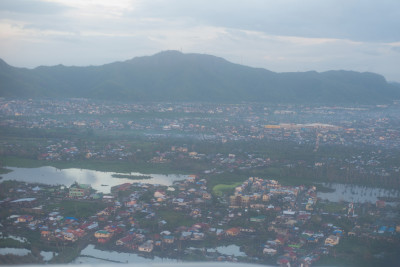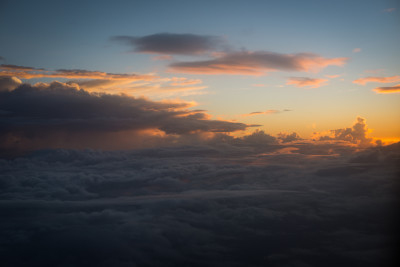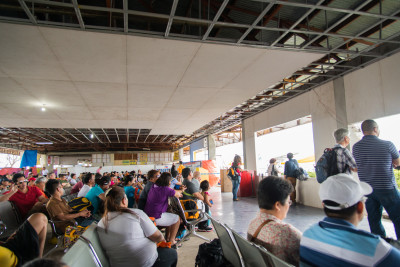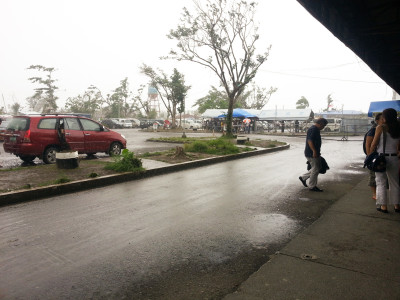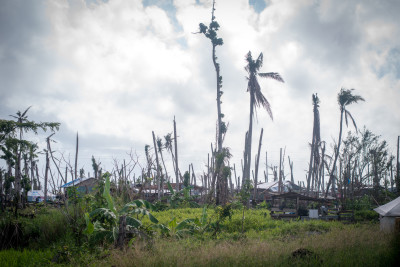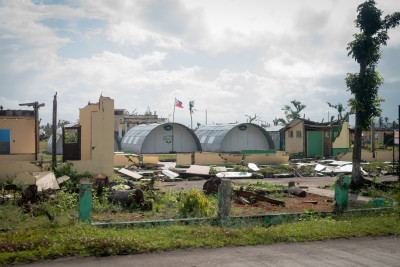Maayong Buntag, Tacloban!
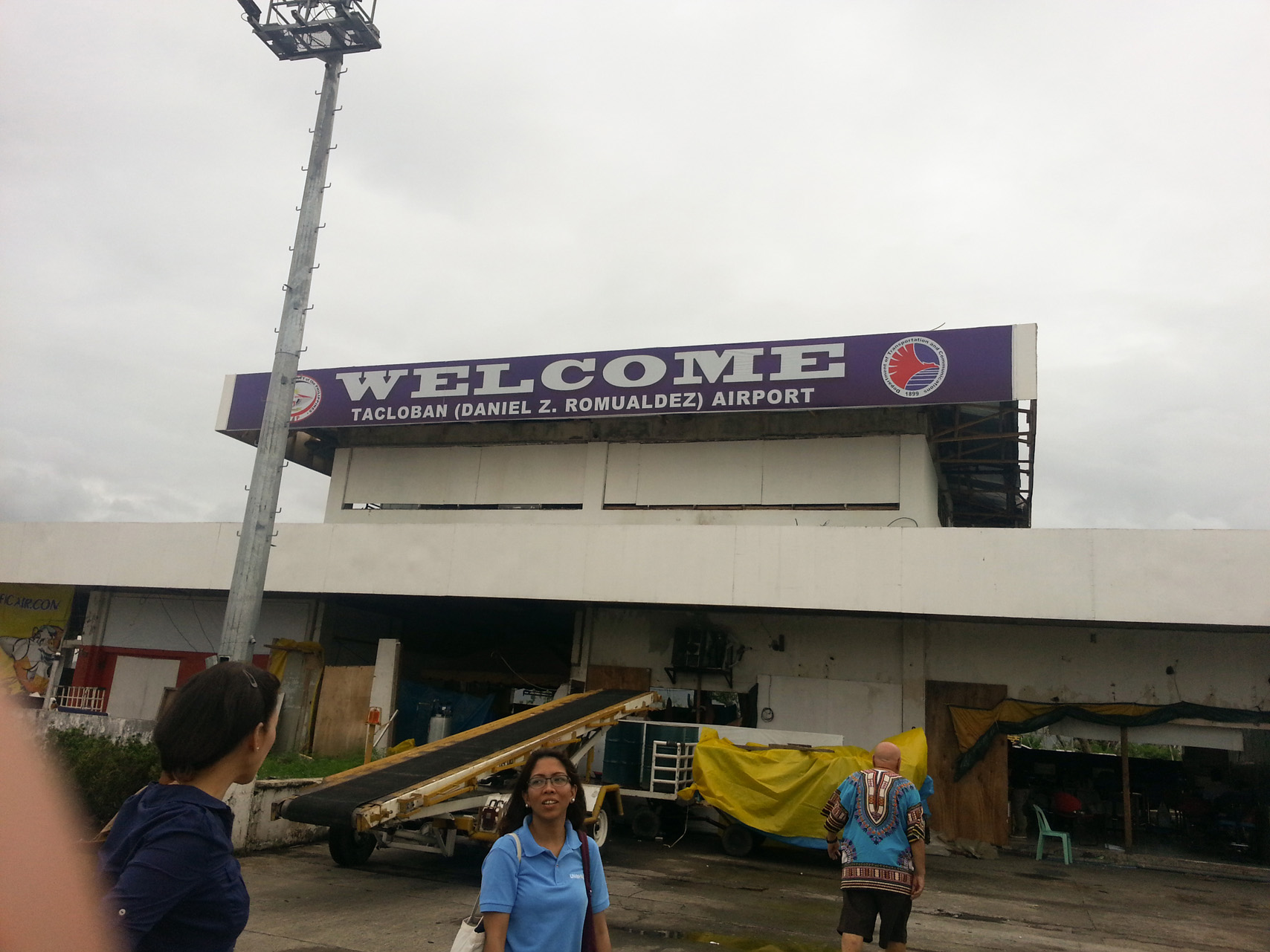
My final flight into Tacloban was the leg of the trip I was most anxious about. Even before I left SFO, I was already going over every possible scenario in my head and once I was in the waiting area at NAIA3 just minutes away from boarding, butterflies filled my stomach and left me shaking with anticipation. During the planning phase of this trip, I did my best to do as much research as possible so that I could be prepared for whatever greeted me once my feet had hit Leyte soil.
However, after the devastation wrought by Haiyan, most of the information I had gathered was rendered useless and outdated. I read reports that Tacloban had no means of public transportation since most of the vehicles were either washed away or turned into scrap metal or that the roads were no longer serviceable.
There were also suggestions from others that it was not advisable to travel alone due to the present condition of the city and its residents. Of course none of that mattered to me, I was going to make my way to Baybay by any means necessary, even if it meant going into Tacloban blind. I didn’t get this far to have second thoughts and give up, so when the announcement for boarding blared on the PA system, I stood ready to face whatever challenges would come my way.
The boarding process was actually rather different than I was used to; the plane was sitting quite a ways away from the boarding gate so we had to ride a bus across the tarmac to get to the plane. It’s amazing how expansive the runway system of a modern airport really is; I felt like an ant making my way through the living floor of a human home.
Once we finally boarded the plane, it took off shortly after and we were finally on our way to Tacloban. The flight itself was not very long, it was less than an hour before the crew started landing preparations. Before all of that, I was able to take some pictures of the sunrise at 30,000 feet; I have to say, Leyte has some really nice cloud formations.
Before I knew it, the plane finally touched down at Daniel Z. Romualdez airport. The plane’s crew mentioned that it was ‘strictly prohibited’ to take pictures while on the tarmac, a warning that I decided to heed since it was my first time here. Looking back on it now, a few pictures probably wouldn’t have bothered anybody so that’s another thing to add to my to-do list for next time. I had seen post-Haiyan pictures of the airport and I was actually pleasantly surprised at how much better it looked in person.
The runway was free of debris and the terminal building’s exterior has been cleaned up considerably with new paneling and signage. However, there was no mistaking that an epic storm passed through here; the terminal building’s concrete structure was really the only thing that really survived the hurricane. There are no windows to keep out the noise, no doors, no ceiling, and no permanent walls; just tarps and makeshift barriers.The ceiling is nothing more than corrugated galvanized steel held up by worn pieces of wood; the type of construction that’s typically seen in home made sheds and car ports here in the States. The terminal improves day by day, thanks to the efforts of the workers who were busy making repairs even while airport operations were in full swing.
- Outside Tacloban Airport terminal building
After a short walk on the tarmac, I made it into the arrivals area of the terminal building and all us passengers were greeted by an energetic, synchronized greeting presented by the airport’s porters, loudly proclaiming “Welcome to Tacloban!”. Since we were the first incoming flight of the day, they saw it fit to present a proper salute to their new guests. I couldn’t help but smile after seeing their enthusiasm and already I felt my inhibitions and fears slowly fading away. Since the baggage carousel had been destroyed by the storm, all of the luggage had to be unloaded in the arrival area by hand. It didn’t take me long to spot my suitcase, I immediately yelled “Kuya!” after one of the porters had handled it so that they could pass it on to me. It took a few tries for them to hear me, but once I switched to my “outside” voice, they just had to look and see where that booming voice was coming from.
With my suitcase in hand, I finally ventured outside of the terminal building’s invisible walls and into the unknown. One of my biggest worries was getting transportation to where I needed to go; I knew that I had to go to a van terminal since they are one of the main modes of transportation in this region, but getting there from the airport was the mystery. Surprisingly, the first few steps outside the terminal, there were locals hawking taxi services and naturally, I asked how much. The first driver answered, P300 and from my research, I recalled that P250 is a more reasonable price so I pitched that to the driver. He rejected it and his fellow drivers agreed that P300 is the going rate now. I thought about walking away, but then I considered that these are post-hurricane prices and a P50 difference (a little over a dollar) was not that big a deal to me, so I said, let’s go buddy!
I have to hand it to Filipino drivers, they’re pretty darn helpful and hospitable; the driver lugged my bag into his waiting van and got the A/C nice and cold for me before we set off.
I asked him to take me to the Duptours terminal, where I can get on a van bound for my final destination. These van companies are one of the popular modes of transportation in the Visayas, they’re fairly affordable, usually have A/C, are much faster and more maneuverable than buses. However, they are not without their downsides, as I would soon find out.
We reached the van terminal in about 20 minutes and I inquired within for information. The office was rather run down and dirty, and I saw a large cockroach scampering about the floor.
I went up to the ladies running the office to ask about a ride through the “Ma-a-sin” route, after which she quickly corrected my pronunciation, “Mah-ahseen”. She said it was P220 and that they would call me once the van was ready to set off; I honestly had no idea if she had mentioned what time it was supposed to leave so I just decided to wait, thinking it can’t possibly be that long. It’s common for the vans to wait for a while so that they can set off with a full load of passengers, but sometimes that just doesn’t happen and just my luck, I was on a van that didn’t come close to filling up. That gave me ample time to check out the van we were going to be riding: a Toyota Hi-Ace with a bald left rear tire. Hi-Aces are basically minibuses capable of seating up to 15 people and are a fairly common sight all over the Philippines. After waiting for about an hour and a half, the driver decided that we had waited long enough and told me to hop in. There were two other passengers in the van, one lady sat next to the driver and seemed to talk to him a good bit, so I figured they must be married or of some relation and the other lady was just a random passenger.
I took this opportunity to snap some pictures of the destruction surrounding Tacloban and as you can see, things are slowly getting better. There’s little to no debris left on the roadways and structures are slowly being rebuilt.
I intended to take more than just a few shots, but as we approached the main highway leading to Southern Leyte, kuya driver picked up speed and unleashed his inner NASCAR driver. As a lover of speed, fast and aggressive driving usually doesn’t faze me, but these van drivers are on another level. I fancy myself aggressive behind the wheel, but on that day, kuya driver made me look like a lightweight. He was barreling down the two lane highway with so much speed, it was difficult to take clear shots of anything passing by and whenever we ran into slower moving traffic, he didn’t hesitate to drive on the wrong side of the road to maintain his course. Keep in mind these vans do not have airbags or seatbelts and may not necessarily be in the best shape mechanically (as evidenced by the single bald rear tire). However, these drivers make these trips daily, regardless of the weather conditions so at least they’re experts in traveling these roads.
When the van leaves the terminal with empty seats like our ride did, the driver will often pick up passengers waiting along the road so I didn’t have the van to myself for very long. We picked up this couple and their little girl not far from Tacloban and they made the trip to Baybay extra memorable, but not for the usual reasons. The way to Baybay involves passing the Mahaplag Crossing, meaning we had to go through a mountainous road full of zig-zags and sudden elevation changes. Before the couple and their daughter came on board, I heard them mention the word ‘suka’, which means ‘vomit’ in Tagalog so you probably already know where this is headed. As soon as we entered the winding mountain road, the girl’s mother pulled plastic a bag over the girl’s mouth and it didn’t take long before the stomach juices started to flow. They sat right behind me so I could hear the fluids splashing into the bag at regular intervals. Most people in the Philippines don’t grow up being driving their own cars and if they need to travel, they typically choose the more affordable forms of public transport, like the slower moving buses, tricycles or jeepneys so when they get on a fast moving van like this one, the experience can be jarring, particularly for the younger kids. This stretch of road goes on for about half an hour, so I figured there must have been two or three bags of vomit to take home that day.
Once we made it through the mountain road, we stopped at Mahaplag Crossing for a much needed breather. There, we were mobbed by street vendors hawking their local delicacies and drinks.
Most of the passengers ignored them, but the vendors continued to persist the whole time we were stopped; for these people, the passing vans and buses may be their only customers for the entire day so I could understand the need to push their goods. We set off again not long after, to push through the final stretch of road before reaching Baybay.
The remainder of the trip wasn’t very long and as we got farther and farther away from Tacloban, the landscape noticeably improved. Houses were less damaged, trees still had their leaves and branches, the whole area just looked like it was less affected by the typhoon. As we began entered Baybay city limits, my heart started racing and I could feel the excitement welling up inside of me. I began to see familiar buildings and landmarks that I previously only saw in pictures. Eventually we made it to the bus terminal and public market, the place that I had heard so much about and when the van stopped and it was time to get off, I knew that after 30 hours of travel, I finally reached my destination. With the grace of God, I had made it.

